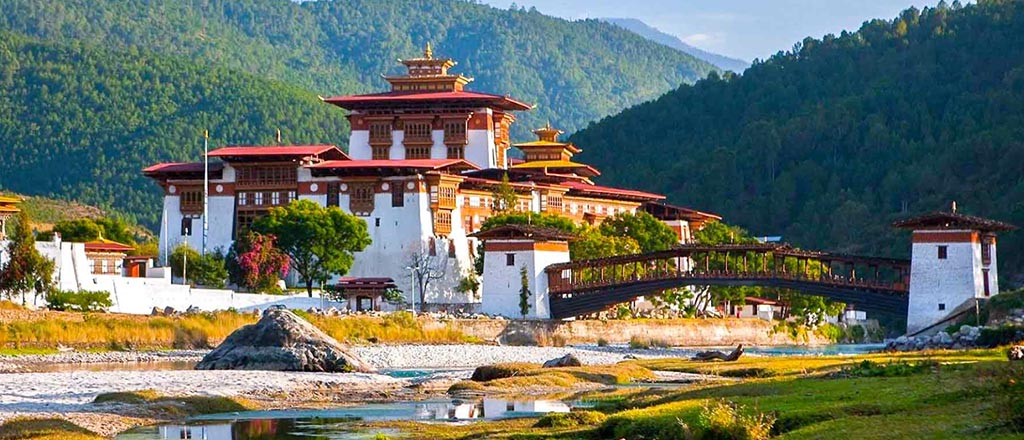
Bhutan’s identity is rooted in the country’s distinct and rich culture and tradition, intertwined with the people’s way of life.
While other countries confront the daunting task of recovering their age-old culture, which has already been lost or is at the risk of being lost due to modernization, Bhutan has been fortunate in that we have been able to retain our rich culture and history.
Thanks to our King’s visionary leadership. Bhutan places a high value on culture and how it influences our people’s way of life, as evidenced by our diverse architecture, festivals, dresses, and sacred locations.
However, as traditional structures are replaced by new, bigger, and modern designs, rapid urbanization and modernization in construction technologies continue to put enormous pressure on the nation’s efforts to preserve and promote its cultural heritage.
So, in this post, we will be taking you through the traditional architecture of Bhutan palaces and the general Bhutanese architectures that are still in practice around the country; read on to know more!
The Bhutanese Architecture
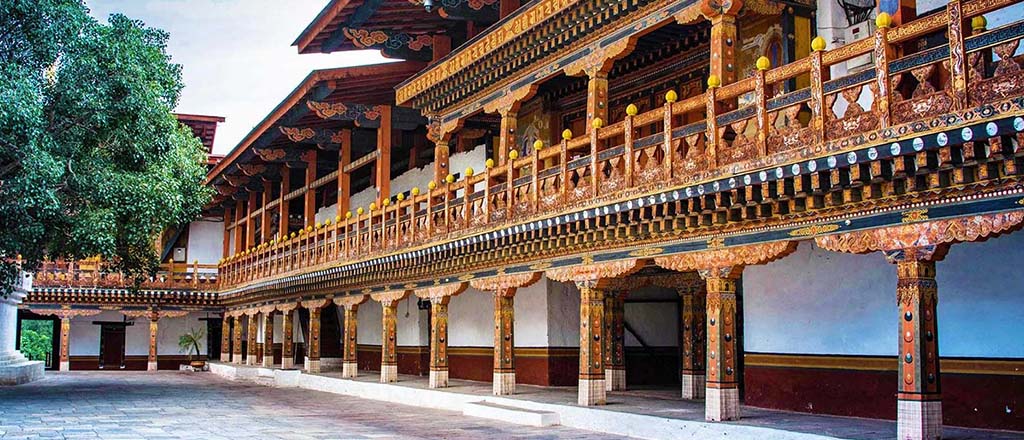
Bhutanese buildings and monuments are one-of-a-kind, stunning displays of Bhutanese craftsmanship.
Bhutan’s varied geography and weather conditions have molded them to look gorgeous and practical.
Bhutan’s architectural system has remained mostly unchanged from its roots in Tibetan, Chinese, and Persian architecture.
Bhutanese architects have produced a distinct style for their country, inventing unique dzongs, temples, and monasteries while maintaining a perfect uniformity of architectural style throughout the country, inspired by ancient forms and concepts.
Because of the abundant availability of raw materials, shingle roofs and half-timbering are a must in Bhutanese architecture and an essential feature of Bhutanese architectural monuments.
The majority of Bhutan palaces were constructed between the 13th and 17th centuries, and hence are cultural monuments of the country.
Architectural Monuments That Define Bhutan
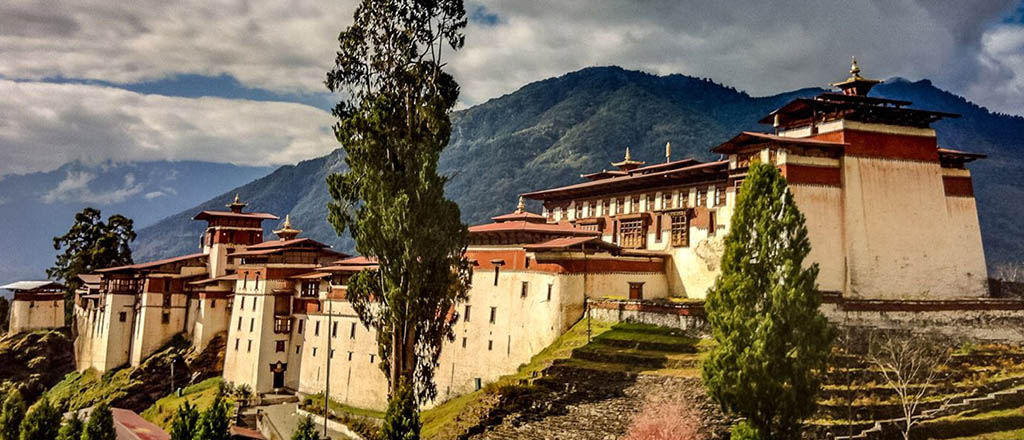
Bhutan is home to many magnificent religious structures. It can be seen in fortresses, temples, stupas, and even in traditional Bhutanese houses.
The fact that Bhutanese architects have kept the traditional way of constructing infrastructures has greatly helped Bhutan sustain its architectural culture.
Given below are six architectural masterpieces that define Bhutan.
1. Dzongs (Fortress)

The most distinctive piece of Bhutanese architecture is the dzong. Dzongs, built to house monasteries and royal administrative offices, are constantly growing up from strategic locations such as river confluences or valley entrances.
The Punakha Dzong, located at the junction of the rivers Pho and Mo Chhu, is a beautiful and important Bhutan palace that also serves as the site for royal weddings.
Dzongs are typically constructed without the use of modern maps or architecture, and they adhere to Bhutan’s old way of construction.
They are the genuine showpiece of Bhutan’s unique architecture and are usually held together without nails (or as few as possible).
2. Chorten (Stupa)
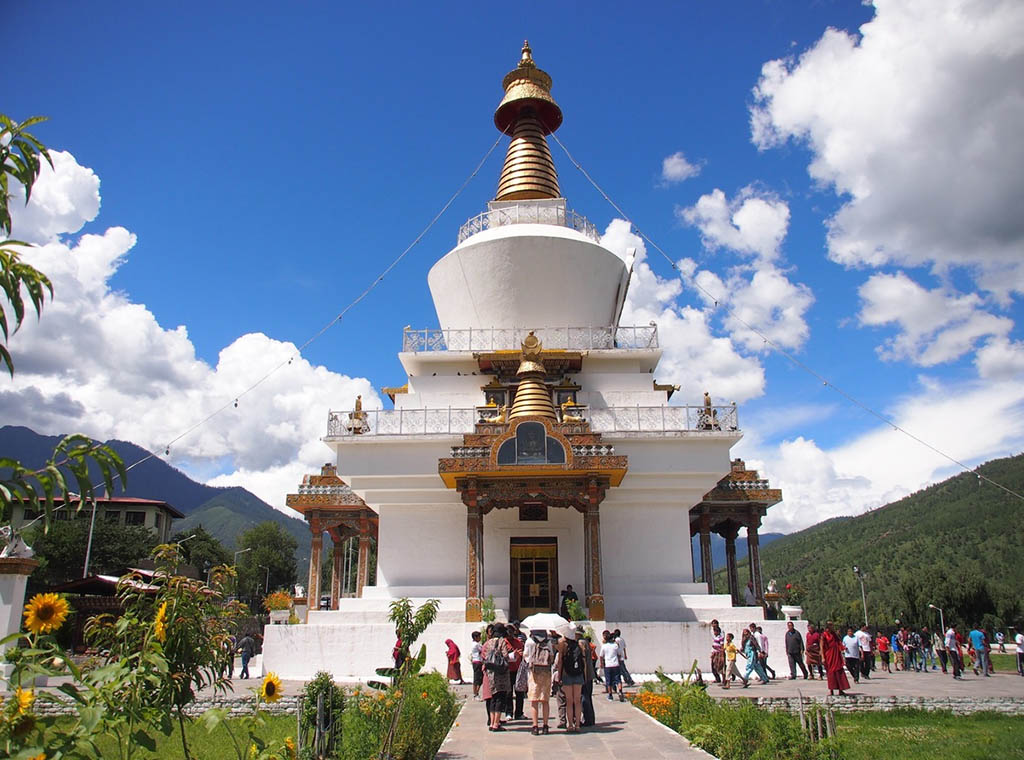
Bhutanese architecture that showcases religion has various distinguishing characteristics, the most visible of which are the chortens (stupas), which can be found throughout the country.
Chortens are the silent harbingers of peace and prosperity in this Himalayan country and are also considered small Bhutan palaces.
They range in bigger sizes located at dzongs and monasteries to smaller installations found around markets and crossroads in cities for the well-being of people and to serve them as their local deities.
3. Lhakhang (Temple)
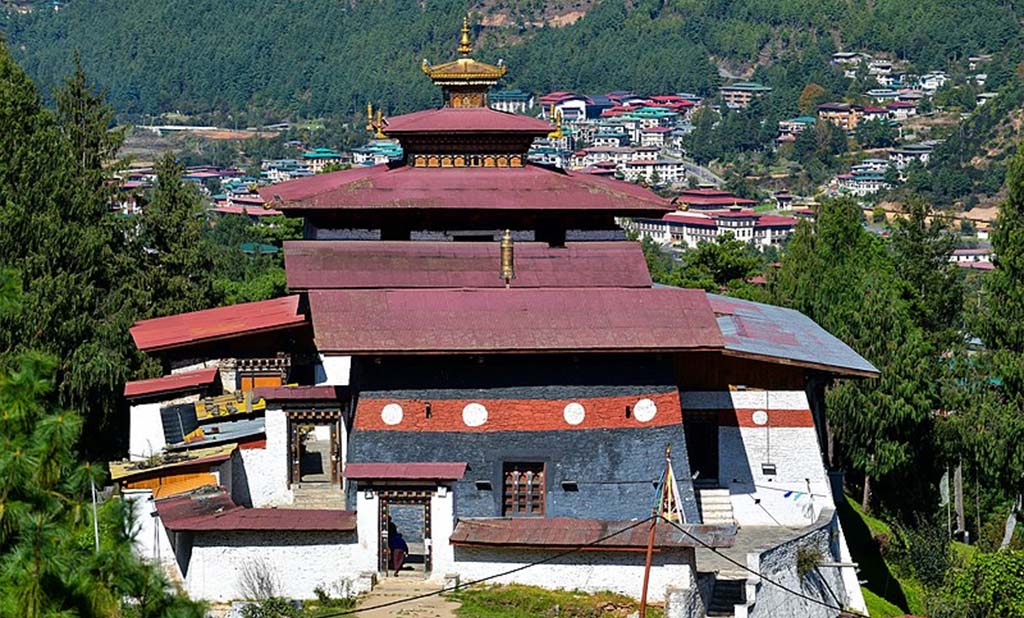
Bhutanese monasteries have their own distinct style of construction that makes them unique to Bhutan palaces.
The Lhakhang were the first types of temples created in Bhutan.
The crimson bands on the upper half of its outside walls and the gilded copper ornaments mounted on the roof distinguish Lhakhang, which is built within a courtyard.
These modest yet beautiful temples can be found all around Bhutan.
4. Goemba (Monastery)
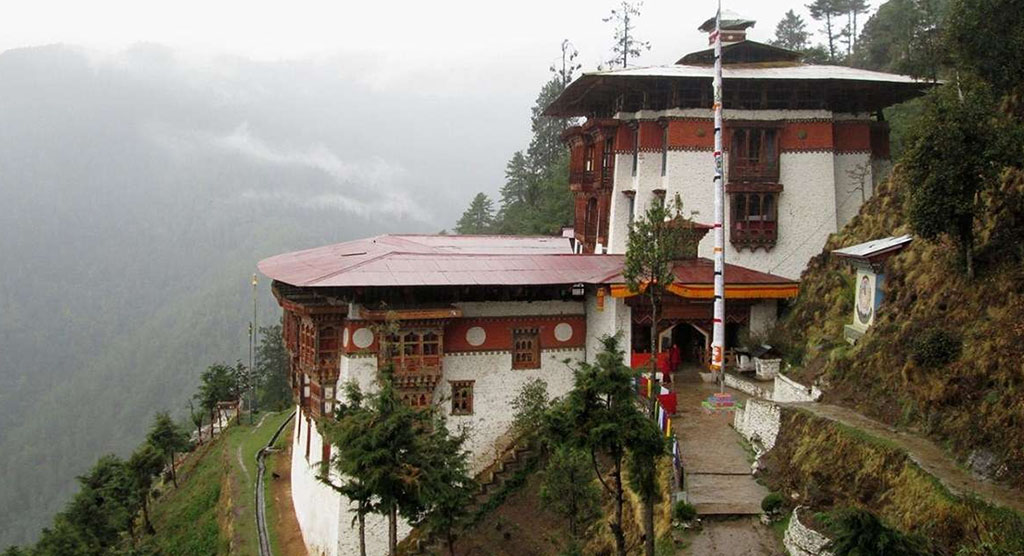
Bhutanese monasteries are known as Goembas, and they are usually built in one of two forms.
In the cluster style, one or two temples constitute the core of the complex, with homes and minor buildings around, such as in the Dzongdrakha of Paro valley.
A tower rings the central Goemba in the other style, and a Bhutan palace/fortress around the Goemba houses monks and different types of prayer rooms.
Materials Used In Constructing Bhutan Palace
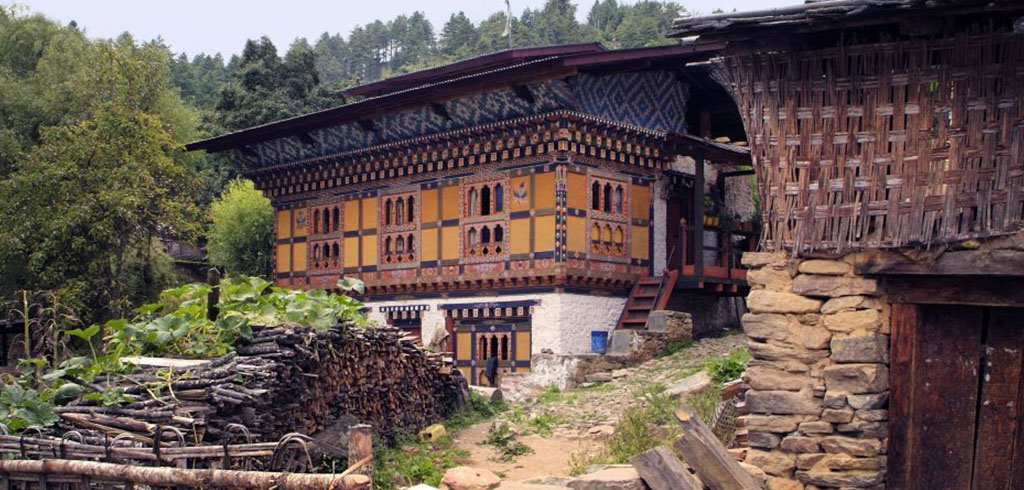
Stone, mud, wood, and bamboo were traditionally utilized in Bhutan to build bridges, chortens, dzongs, residences, palaces, temples, and monasteries.
Masonry and stone arts were used to construct the outer walls of Bhutan palaces, temples, monasteries, stupas, massive fortresses, and other structures.
Wood and timber are abundant in Bhutan, and they are lavishly employed for structural features such as windows, doors, staircases, balconies, columns, and beams.
Bhutanese people love to paint their houses with bright colors giving their homes and buildings a vibrant and festive appearance.
In Bhutan, wooden floors and ceilings are very popular, as stated above, because of the abundance of timber.
Bhutanese houses are known for their ‘flying roofs.’ This form of roof is tall and constructed of wooden shingles held in place by stones, allowing for a big, open, and airy space beneath the roof.
A staircase is frequently made up of a single log with ledges cut onto one side.
Murals and carvings of Lord Buddha and other deities can be found on the walls and altars of Bhutan palaces, and practically every home has a wooden altar with statues of the Buddha and other guardian deities.
Palaces In Bhutan

As you have read about the magnificent works of art in creating Bhutan palaces by the Bhutanese, now it is time to look at some of the most beautiful palaces that can be visited if you are planning your trip to Bhutan with Norbu Bhutan.
They are not far away from the cities, so it will not take much time to go and witness the authentic traditional architecture of Bhutan that will leave you astonished.
Given below are some of the palaces in Bhutan.
1. Kuenga Rabten Palace
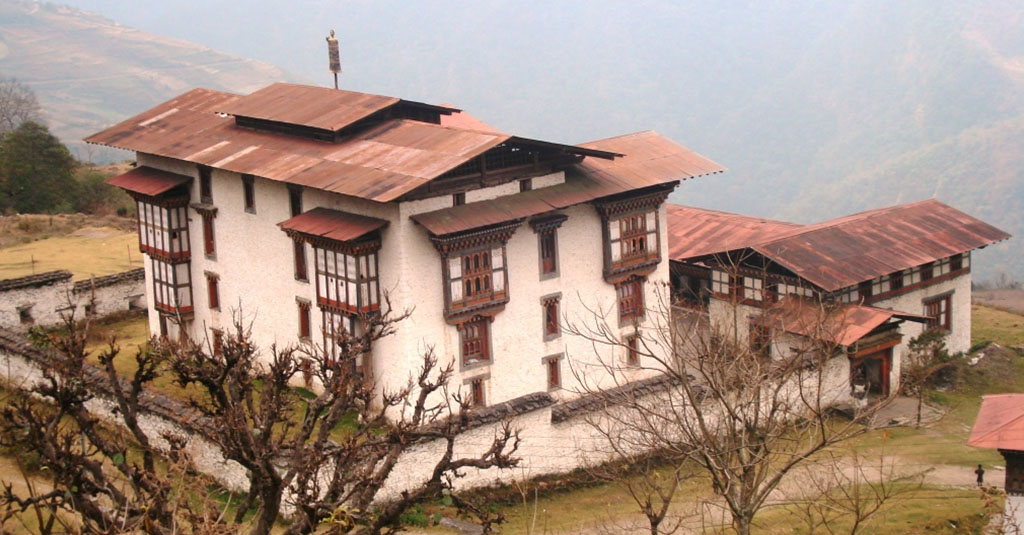
Kuenga Rabten Bhutan Palace is located in Trongsa and takes about an hour to drive there from the town. Many gorgeous farms and villages can be seen along the way.
This palace was the second King’s winter residence, but it is now the National Commission for Cultural Affairs.
It has statues of Guru Rinpoche and Shakyamuni and superb woodwork, crafts, and paintings that give light to traditional architecture.
2. Ugyen Pelri Palace

The Ugyen Pelri Palace, built in the early 1900s, is a magnificent example of Bhutanese architecture.
It was modeled by Paro Penlop Tshering Penjor and is also known as Guru Rinpoche’s paradise.
Penlop himself designed the palace, and all of the architectural details were done by him during the construction.
It is a true masterpiece among Bhutanese palaces and is now the official residence of Bhutan’s queen mother. However, the palace is not open to the public or tourists.
3. Dechenchoeling Palace
This Bhutan palace is a three-storied structure with willow trees, meadows, and ponds surrounding it.
Members of the Royal family, aside from the current King, reside here in this magnificent architectural masterpiece.
The building, including the interior furnishings, is in Bhutanese traditional style that is unique without the touch of modern design.
4. Wangduechhoeling Palace
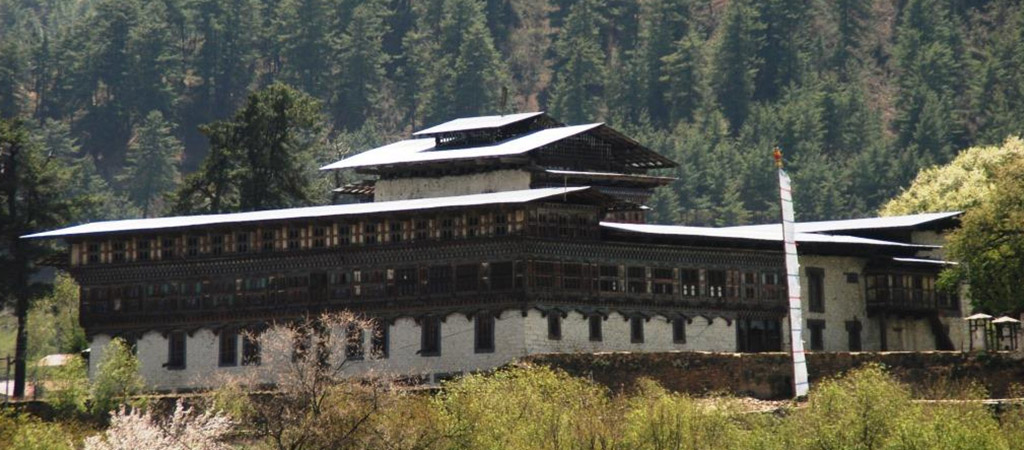
The palace constructions are still considered outstanding examples of traditional Bhutanese architecture from the eighteenth century.
The complex, which was erected around a central courtyard and holds precious murals, manuscripts, sculptures, and textiles, is characterized by white stone walls linked with mud mortar and richly decorated timber elements.
Vandalism, robbery, and the development of a luxury hotel nearby aroused worries about Wangduechhoeling Palace’s protection and preservation; therefore, it was added to the 2012 World Monuments Watch list.
Although modernization is taking Bhutan by storm, Bhutan has successfully preserved and protected its monumental architecture for over 100 years and claims that it will be the same in the future.
Take time to tour Bhutan and visit Thimphu, Punakha, Paro, and other sites in the country, where you’ll find exquisite traditional architecture with the unique features stated above.
So, what are you waiting for? Contact Norbu Bhutan now and experience these cultural treasures!
Or you can visit our website to read about 5 soul-rejuvenating hotspots in Bhutan, that will make you want to visit this magnificent country.


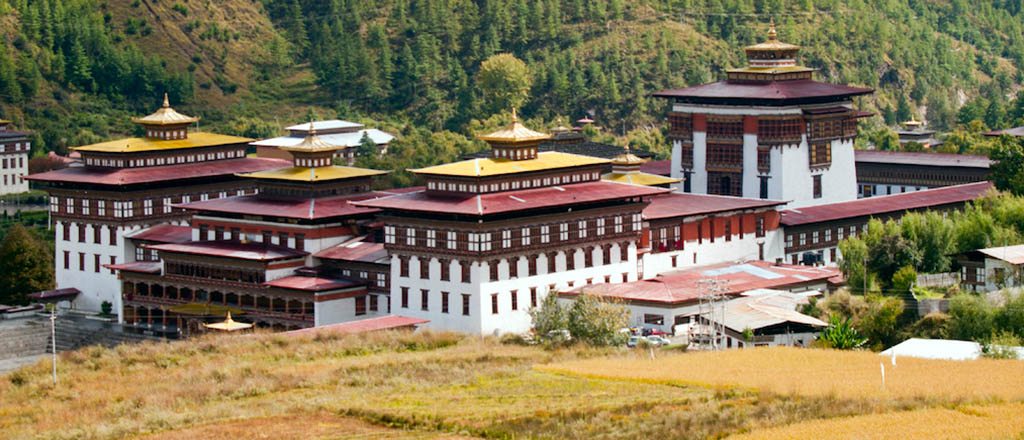
No responses yet